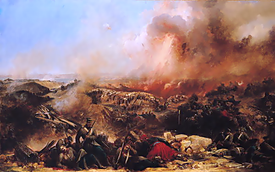William Hope (VC)
| William Hope | |
|---|---|

Depiction of the Siege of Sebastopol
|
|
| Born |
12 April 1834 Edinburgh, Scotland |
| Died | 17 December 1909 (aged 75) Chelsea, London |
| Buried at | Brompton Cemetery |
| Allegiance |
|
| Service/branch |
|
| Rank | Colonel |
| Unit | 7th Regiment of Foot |
| Battles/wars | Crimean War |
| Awards |
|
| Relations | John Hope (father) |
Colonel William Hope VC (12 April 1834 – 17 December 1909) was a Scottish recipient of the Victoria Cross, the highest and most prestigious award for gallantry in the face of the enemy that can be awarded to British and Commonwealth forces.
William Hope was the son of the Right Honourable John Hope, Lord Chief Justice Clerk of Scotland, and his wife Jessie Irving, and was born in Edinburgh on 12 April 1834. He was educated privately and at Trinity College, Cambridge.
William Hope married Margaret Jane, daughter of Robert Cunningham Cunninghame Graham of Gartmore and aunt of the author, politician and traveller Robert Bontine Cunninghame Graham, by whom she had six children, the eldest of which was a son, Adrian, whose granddaughter, Lauretta Hope-Nicholson, was the second wife of the artist Jean Hugo.
He was 21 years old, and a lieutenant in the 7th Regiment of Foot (later The Royal Fusiliers), British Army during the Crimean War when the following deed took place for which he was awarded the VC.
On 18 June 1855 at Sebastopol, Crimean Peninsula, Lieutenant Hope went to the assistance of the adjutant, who was lying outside the trenches badly wounded. Having found that it was impossible to move him, even with the help of four men, he ran back across the open ground under very heavy fire from the enemy batteries, and procured a stretcher to bring the wounded officer in.
He later achieved the rank of colonel. Hope invented a form of shrapnel shell for rifled guns, and later became an enthusiastic supporter of the volunteer movement, rising to the command of the 1st City of London Artillery Volunteers.
...
Wikipedia
